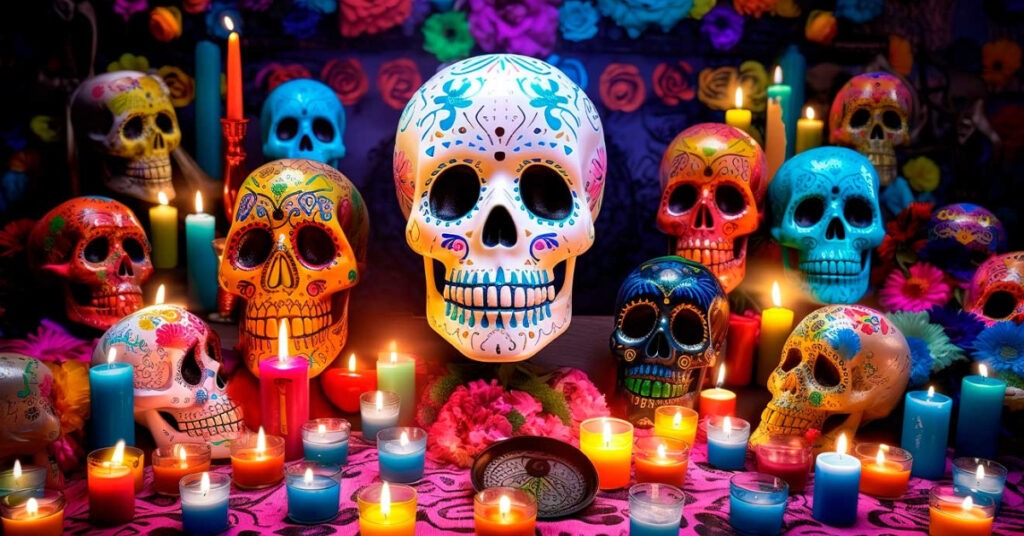The Day of the Dead, or Día de los Muertos, stands as one of Mexico’s most emblematic and culturally significant celebrations. Rooted deeply in pre-Hispanic traditions, this festivity intertwines the indigenous veneration of the deceased with Catholic rituals introduced by the Spanish, creating a unique cultural expression that resonates across the country.
A Journey Through Time: The Origins of the Day of the Dead
In pre-Hispanic times, death was not seen as an end but as a passage to another realm. The Mexicas, Mixtecs, Texcocanos, Zapotecs, Tlaxcaltecas, Totonacs, and other indigenous groups believed that when someone died, they embarked on a journey to Mictlán, the underworld. To aid them on this journey, the deceased were buried wrapped in a mat, and their families held a feast to guide their souls. Offerings of food were placed beside them, a practice rooted in the belief that the souls might feel hunger on their long voyage.
This ancient tradition evolved over time, particularly after the Spanish conquest, as the indigenous practices blended with Catholic rituals. The result is a celebration that honors the dead not as an absence but as a living presence, a day when the souls of the deceased temporarily return to the world of the living to reunite with their loved ones.
The Symbolism of the Day of the Dead
For many Mexicans, the Day of the Dead is more than just a day of remembrance; it is a profound celebration of life and death. Altars, known as ofrendas, are meticulously decorated with marigold flowers, papel picado (colorful tissue paper), sugar skulls, and the traditional pan de muerto (bread of the dead). Each element on the altar holds deep symbolic meaning. Marigolds, or cempasúchil, are believed to guide the spirits to their altars with their vibrant color and strong scent. Incense, often made of copal, is burned to purify the area and communicate with the spiritual realm.
Food plays a central role in these offerings, echoing the practices of pre-Hispanic cultures. Families prepare the favorite dishes of their departed loved ones, believing that the souls return to savor the essence of the food. This act of cooking and sharing meals is not only a way to honor the dead but also to keep their memory alive within the family.
Regional Variations Across Mexico
While the Day of the Dead is celebrated nationwide, the traditions and customs vary significantly from region to region, each adding its unique flavor to the festivity.
In Mexico City, the small town of Mixquic in the Tláhuac municipality becomes a focal point during these days. Known for its adherence to traditional customs, Mixquic hosts a celebration culminating in “La Alumbrada” on November 2nd. Thousands of candles illuminate the graves, which are adorned with flowers, creating a hauntingly beautiful scene that attracts visitors from all over.
Oaxaca, a state rich in cultural heritage, is another key location where the Day of the Dead takes on a profound significance. Altars in Oaxaca are often adorned with white tablecloths or papel picado and are structured in steps, each representing different levels of the afterlife. The first step typically honors grandparents and adults, while the subsequent steps are dedicated to other family members. The entire city comes alive with exhibitions, parades, and cultural events that highlight the deep connection between the living and the dead.
In Michoacán, the island of Janitzio and the town of Pátzcuaro are famous for their Day of the Dead celebrations. The indigenous Purepecha people maintain age-old traditions, including night-long vigils at cemeteries, where families gather to honor their ancestors with music, food, and the warm glow of candlelight.
Other notable celebrations include those in Xochimilco, Mexico City, where decorated boats called trajineras carry families to the cemetery, and Cuetzalán in Puebla, where the festivities are infused with the rich cultural traditions of the Totonac people.
A Cultural Heritage of Humanity
In recognition of its deep cultural and social significance, the United Nations Educational, Scientific and Cultural Organization (UNESCO) declared the Day of the Dead as an Intangible Cultural Heritage of Humanity in 2008. UNESCO acknowledged that this celebration not only represents a living tradition but also serves as a crucial social function by affirming the role of the individual within the community.
For Mexico’s indigenous communities, the Day of the Dead is a moment to strengthen cultural identity and social ties. It is a time when memory triumphs over oblivion, and the bonds between the living and the deceased are reaffirmed through rituals, prayers, and communal gatherings.
A Unifying Celebration Across Mexico
Despite regional differences, the essence of the Day of the Dead remains consistent throughout Mexico: it is a celebration of memory, family, and the continuity of life. Families come together to honor their ancestors, to welcome the souls who return from the afterlife, and to celebrate the cycle of life and death that has been a part of Mexico’s cultural fabric for centuries.
The Day of the Dead is more than just a festival; it is a profound expression of the Mexican worldview, where death is not feared but embraced as a natural part of life. As the altars glow with the light of countless candles and the air fills with the scent of marigolds and incense, the living and the dead are brought together in a celebration that transcends time and space, reminding us all of the enduring power of memory.
